呼吸道病毒的高通量人体组织模型:自动化使用人体气道上皮组织以更快地发现药物
IF 2.7
4区 生物学
Q2 BIOCHEMICAL RESEARCH METHODS
引用次数: 0
摘要
药物发现的动物实验是昂贵的,在体内模型中测试化合物的决定应该仔细考虑。此外,FDA现代化法案允许使用动物模型来测试候选药物的安全性和有效性。在这些替代方案中,人类组织模型提供了与人类相关的环境。专门的细胞类型可以从原代人类细胞中产生,并用于基础研究和药物发现目的。其中之一是用于呼吸道疾病研究的3D模型,由人类来源的气管/支气管上皮细胞组成。虽然这种人类气道上皮(HAE)模型目前被许多研究人员所采用,但这项工作主要是使用放置在6孔板中的单个组织插入物来完成的。这种低通量的方法是劳动密集型的,耗时和昂贵的(每个化合物筛选的成本很高)。我们已经建立了一种高通量HAE试验,可用于化合物筛选,以推进呼吸道病毒项目。这很重要,因为它允许在体内测试之前对更多的化合物进行评估,从而在后期发现阶段对候选化合物进行更全面的比较。我们开发了96孔的流感病毒、呼吸道合胞病毒(RSV)和冠状病毒(包括SARS-CoV-2)化合物的检测方法,这些检测方法很容易适用于其他呼吸道病毒,如人偏肺病毒(HMPV)。开发过程包括对每种病毒进行50%组织培养感染剂量(TCID50)的滴定计算,并在时间过程实验中确定最佳HAE感染时间,过程的每一步都是自动化的,以提高速度和精度。在感染HAE组织后,用细胞病变效应(CPE)或病毒滴度降低(VTR)法在适当的细胞系中评估顶端收集的样本中感染性病毒的数量。优化后的检测结果一致显示Z值>;0.75,用于检测各抗病毒实验相关的参比化合物。奥司他韦和利巴韦林对H3N2 A/Udorn/72的效价分别为100 nM和5.3µM。简化的分析开发过程强调了将HAE分析从放置在6孔板内的单个组织插入物小型化到96孔格式的好处,为人体3D体外呼吸组织模型提供了高通量解决方案。本文章由计算机程序翻译,如有差异,请以英文原文为准。
A high-throughput human tissue model for respiratory viruses: Automating the use of human airway epithelial tissues for faster drug discovery
Animal testing for drug discovery is expensive and the decision to test a compound in an in vivo model should be carefully considered. In addition, the FDA Modernization Act has resulted in the allowance of alternatives to animal models for testing the safety and efficacy of drug candidates. Among these alternatives are human tissue models that provide a human-relevant context. Specialized cell types can be produced from primary human cells and used for basic research and drug discovery purposes. One of these is a 3D model for respiratory disease research, consisting of human-derived tracheal/bronchial epithelial cells. Though this translational Human Airway Epithelial (HAE) model is currently being employed by many researchers, this work is primarily done using individual tissue inserts placed in 6-well plates. This low-throughput approach is labor-intensive, time-consuming and expensive (high cost per each compound screened). We have established a high-throughput HAE assay that can be used for compound screening to advance respiratory virus programs. This is significant as it allows a higher number of compounds to be evaluated before being tested in vivo, allowing a more comprehensive comparison of candidates at this later discovery stage. We developed 96-well assays to evaluate compounds for Influenza, Respiratory Syncytial Virus (RSV) and Coronaviruses (including SARS-CoV-2), and these assays are easily adaptable to other respiratory viruses like Human metapneumovirus (HMPV). The development process involved performing a titration of each virus for 50 % tissue culture infectious dose (TCID50) calculations and determining the optimal HAE infection time in a time course experiment, with every step of the process automated to increase speed and precision. Following infection of the HAE tissues, the amount of infectious virus in apically collected sample was assessed in a Cytopathic Effect (CPE) or Virus Titer Reduction (VTR) assay in an appropriate cell line for that particular virus. The optimized assays consistently showed Z’ values > 0.75 and were used to test reference compounds relevant to each antiviral assay. Potency values for oseltamivir and ribavirin against H3N2 A/Udorn/72 were 100 nM and 5.3 µM, respectively. The streamlined assay development process highlights the benefits of miniaturizing HAE assays from individual tissue inserts placed inside a 6-well plate to a 96-well format, providing a high-throughput solution for human 3D in vitro respiratory tissue models.
求助全文
通过发布文献求助,成功后即可免费获取论文全文。
去求助
来源期刊

SLAS Discovery
Chemistry-Analytical Chemistry
CiteScore
7.00
自引率
3.20%
发文量
58
审稿时长
39 days
期刊介绍:
Advancing Life Sciences R&D: SLAS Discovery reports how scientists develop and utilize novel technologies and/or approaches to provide and characterize chemical and biological tools to understand and treat human disease.
SLAS Discovery is a peer-reviewed journal that publishes scientific reports that enable and improve target validation, evaluate current drug discovery technologies, provide novel research tools, and incorporate research approaches that enhance depth of knowledge and drug discovery success.
SLAS Discovery emphasizes scientific and technical advances in target identification/validation (including chemical probes, RNA silencing, gene editing technologies); biomarker discovery; assay development; virtual, medium- or high-throughput screening (biochemical and biological, biophysical, phenotypic, toxicological, ADME); lead generation/optimization; chemical biology; and informatics (data analysis, image analysis, statistics, bio- and chemo-informatics). Review articles on target biology, new paradigms in drug discovery and advances in drug discovery technologies.
SLAS Discovery is of particular interest to those involved in analytical chemistry, applied microbiology, automation, biochemistry, bioengineering, biomedical optics, biotechnology, bioinformatics, cell biology, DNA science and technology, genetics, information technology, medicinal chemistry, molecular biology, natural products chemistry, organic chemistry, pharmacology, spectroscopy, and toxicology.
SLAS Discovery is a member of the Committee on Publication Ethics (COPE) and was published previously (1996-2016) as the Journal of Biomolecular Screening (JBS).
 求助内容:
求助内容: 应助结果提醒方式:
应助结果提醒方式:


